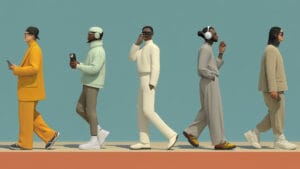Not every experience we have with a brand leaves a trace, but the ones that do often share something in common: a sense of ease. The right tone. A clear next step. The feeling that someone thought things through for us.
In a world where digital interactions are multiplying and systems are learning to anticipate our needs more than ever, this kind of quiet clarity is becoming a rare currency. Not loud, not flashy. Just comfortable. Reassuring. Easy to trust.
It’s what psychologists call psychological comfort, and what some of us in design or strategy have long tried to create, whether through words, visuals, or flows. Today, it feels less like a finishing touch and more like an essential layer in building meaningful connections.
What Psychological Comfort Really Means in Brand Experience
It’s easy to think of marketing as persuasion. But before any of that can happen, something else needs to click first: the feeling of being in the right place.
Psychological comfort in this context isn’t about grand emotional gestures or flawless messaging. It’s about the small, thoughtful cues that quietly say:
- “You’re understood.”
- “This is for you.”
- “You are free to explore without pressure.”
It can come from visual balance. From a message that doesn’t overpromise. From a journey that feels natural rather than rushed.
In other words, it’s the difference between being sold to and being welcomed in.
Psychological comfort is often what keeps users engaged longer, builds trust over time, and encourages loyalty without forcing decisions. It complements performance goals rather than replacing them, helping create the emotional foundation that supports sustainable outcomes.
As more parts of the customer and employee journey are influenced by intelligent systems, preserving this sense of comfort becomes even more important. It is what keeps the human connection alive, even in highly optimized environments.
When Systems Start to Undermine Comfort
As tools become smarter, they also become faster. More connected. More predictive. More responsive.
But in the pursuit of frictionless experiences, something subtle can happen: the interaction starts to feel tight. Too certain. Too fast. Too scripted. As if every step has already been decided, leaving little room for the natural rhythm of human decision-making.
And that’s where a disconnect often begins.
Because psychological comfort isn’t just about making things efficient. It’s also about tempo, about having just enough space to think, to pause, to feel like the next move is still ours to make.
What feels intuitive to a system may sometimes feel abrupt to a person. And when processes become too perfectly engineered, we risk removing the gentle pauses that help people feel comfortable, considered, and in control.
There is even a strange kind of reassurance in imperfection: When a response takes a breath before arriving. When a choice is presented simply, without urgency. When a system offers support without assuming it already knows everything.
These are not inefficiencies to be eliminated. They are signs of life, of attentiveness, of human rhythm.
Of course, not every interaction needs to slow down. Urgency and efficiency have their place, especially when the context calls for swift action. The key lies in being mindful, knowing when to optimize for speed, and when to create space for comfort.
This reflection is valid not only for consumer experiences but also within organisations. It matters in B2B relationships, in knowledge sharing across teams, and in the everyday flow of communication at work. Because wherever people interact with systems, or with each other, comfort shapes trust, openness, and engagement.
When Systems Help Us Feel at Ease
Not all automation leads to tension. When built with care, it can be the very thing that enhances psychological comfort.
At their best, intelligent systems can:
- Anticipate needs without overwhelming.
- Offer structure without rigidity.
- Create clarity without narrowing choice.
Think of a well-paced onboarding flow that adapts based on real engagement. Or a dashboard that surfaces what matters most in that moment. Or a follow-up message that feels timely and considerate, rather than persistent.
These touches remind us that systems, when thoughtfully designed, can support the human experience rather than steer it too tightly.
Small details matter. A tone of voice that feels natural. A momentary pause before prompting the next action. An option to explore deeper, without pressure.
Through these choices, we are not losing efficiency. We are building trust, creating resonance, and allowing the person behind the screen to feel seen, not steered.
In many ways, this is where the real opportunity lies. Not in making systems faster for the sake of it, but in designing environments where people can think clearly, act freely, and feel genuinely supported.
A Shift in Mindset for Designers, Marketers, and Leaders
It’s tempting to focus on what is easiest to measure: Response times. Engagement rates. Conversion metrics.
But if we only chase speed and clicks, we might miss something far more lasting: How an experience makes people feel.
Psychological comfort isn’t about slowing progress or rejecting innovation. It is about bringing emotional intelligence into systems thinking. It is about complementing hard performance metrics with soft, human-centered design choices that foster real engagement.
There is room to ask different kinds of questions:
- Are we building clarity, or just moving information faster?
- Are we respecting attention, or simply trying to capture it?
- Are we making it easy to trust, or simply easy to react?
In a landscape increasingly supported by automation and data, choosing to design for psychological comfort is choosing to design for people.
Personally, this is the space where I feel most inspired to work today. At the intersection of thoughtful systems and human needs. Finding ways to build experiences that not only perform, but resonate. That don’t just move fast, but move right.
An Open Invitation
As we shape the next generation of experiences, maybe the real opportunity is not about how fast or clever we can be. Maybe it is about how thoughtfully we can move.
What small gestures of psychological comfort could we create if we chose to design with people, not just for them?
I would love to hear your thoughts. Where do you see opportunities to bring a little more ease, clarity, and care into the journeys you shape?



